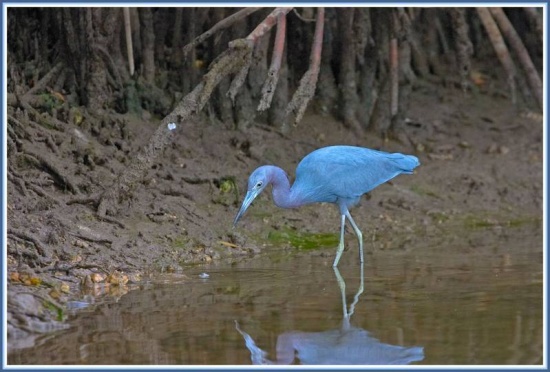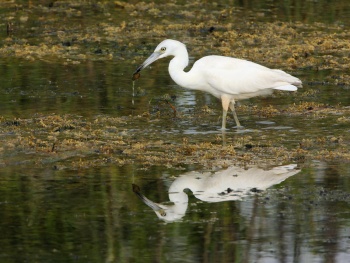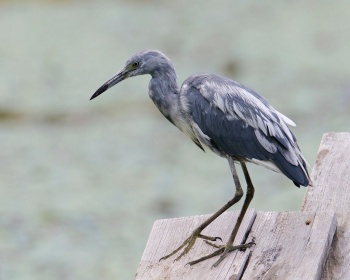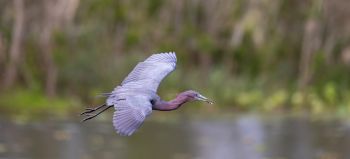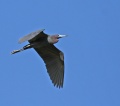- Egretta caerulea
Identification
Height 51–76 cm (20-30 in)
Ws. 102 cm
Weight 325 g
Sexes similar
Breeding Adult
- Blue-grey body
- Purplish head and neck
- Long blue plumes
- Dark blue legs and feet
Non-breeding Adult
- Dark blue head and neck
- Paler legs
Immature
- All white except for dark wing tips and have
- Yellowish or greenish legs
Gradually acquire blue plumage as they mature. Will usually start the process during their first year of life and be completed when they are a little more than 1 year old.
Similar species
For the adult, the two-toned bill helps separating from Reddish Egret. The white juvenile can be mistaken for Western Cattle Egret, Snowy Egret and Little Egret, but notice that the details of the bill should help get the right identification relative to all three.
Distribution
Found along east coast north to Massachusetts, along the Mississippi north to Missouri, and to about 150 miles north of the Gulf Coast. Regularly found 300 miles north of breeding range. Rare vagrant north of that.
Occurs throughout the West Indies and in Mexico breeds on both coasts and south to Panama. In South America ranges south to northern Chile in the west and Uruguay in the east.
Northern birds migrate south to winter in Florida, the West Indies and South America.
Taxonomy
This is a monotypic species[1].
Habitat
Swamps, flooded grasslands and lagoons, also coastal habitats in some areas.
Behaviour
Breeding
They nest in colonies, often with other herons, usually on platforms of sticks in trees or shrubs. The clutch consists of 3-7 light blue eggs.
Diet
Their diet consists of slow moving, bottom feeding shellfish, crustaceans and insects such as dragonflies.
Gallery
Click on photo for larger image
Juvenile
Photo © by Waltbulmer
Bozman Maryland county, October 2018
References
- Clements, J. F., T. S. Schulenberg, M. J. Iliff, S. M. Billerman, T. A. Fredericks, B. L. Sullivan, and C. L. Wood. 2019. The eBird/Clements Checklist of Birds of the World: v2019. Downloaded from http://www.birds.cornell.edu/clementschecklist/download/
- Rodgers Jr., J. A. and H. T. Smith (2020). Little Blue Heron (Egretta caerulea), version 1.0. In Birds of the World (A. F. Poole, Editor). Cornell Lab of Ornithology, Ithaca, NY, USA. https://doi.org/10.2173/bow.libher.01
- Wikipedia
- BF Member observations
- Alvaro Jaramillo. 2003. Birds of Chile. Princeton Field Guides. ISBN 0-691-11740-3
Recommended Citation
- BirdForum Opus contributors. (2025) Little Blue Heron. In: BirdForum, the forum for wild birds and birding. Retrieved 11 May 2025 from https://www.birdforum.net/opus/Little_Blue_Heron
External Links
GSearch checked for 2020 platform.1




